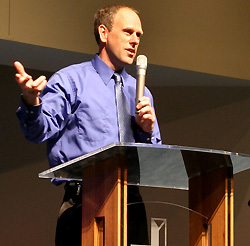Producing great sound in a worship service can seem as elusive as finding a soloist who always sings on key.
However, this doesn’t have to be so.
Many factors influence the quality of sound: room acoustics, sound-system design and performance, operator experience, and quality of musical performance.
Here are some practical tips on how to tie all of that together to get the best sound.
Understand the Basics
To get the most out of a sound system, you must first understand how it works.
Basically, acoustic energy, or the sound you make, is converted to electrical energy via a microphone, then combine with other mics or input devices, and are then “colored” or equalized via a mixer.
The mixer sends the sound through processing equipment (crossover, equalizer, signal delay, usually a single DSP box), then to amplifiers to boost the signal. Finally, the amplified signal goes to speakers, where it’s transferred back to acoustic energy.
The key components of sound-processors, amplifiers, and speakers-should be professionally designed and set in a church, then left alone. The mixing board is where you should make adjustments in tone and sound levels.
Build a Sound Team
A sound system won’t run by itself. It needs a sound crew to function to its true potential. Some ideas on recruiting and developing a good crew:
I like to recruit one-on-one, much like a hunter who goes to the woods looking for a specific target. The hunter may see ducks, squirrels, and turkeys, but he sits tight for a certain kind of deer. When he sees exactly what he’s looking for, he pursues it with vigor.
Be the same way when developing a sound team. Decide what kind of people you need, and then recruit them vigorously.
You could also try the fishing-pond approach. That means recruiting candidates from a select gathering of people.
For example, when Marty O’Connor was at Willow Creek Community Church in South Barrington, Illinois, he and his video crew offered a yearly seminar on how to make great home movies with your camcorder.
After the seminar, the crew would bring out their studio cameras and invite seminar attendees to try operating one of the “big boys.”
All the while they’d look for people in that “pond” with special aptitude for working on a video crew. Then they’d recruit them. Members of a sound crew might be found through a similar approach.
Grow A Team
The acronym TEAM – meaning “Together Everybody Achieves More” – particularly applies to a sound crew. To be truly effective, team members must grow together on the job in knowledge and experience as well as in spirit and emotion.
Make sure that you provide spiritual, emotional, and technical food for sound-team members.
When I was on staff at a large West Michigan Church, every week, I spent about 30 minutes in prayer and devotions with my sound crew before our hour-plus sessions in sound training. That time helped unite us and focus our work.
It’s also important to keep the team informed of what’s happening in the sound industry, such as regular visits to ProSoundWeb and reading other industry publications and sites.
Finally, to encourage ownership and 100-percent participation, every sound-crew member should be encouraged to make suggestions about the sound system. I took seriously crew member suggestions on equipment purchases.
Thank the team. Saying thanks is powerful, but showing thanks is even better. My favorite way of showing gratitude to crew members was to send thank-you notes to them and their spouses.


















